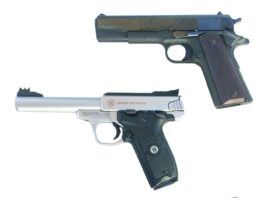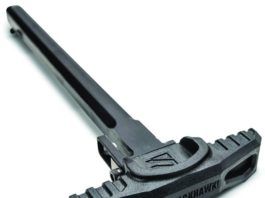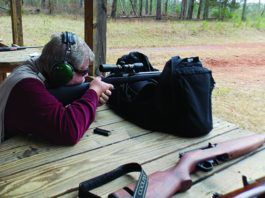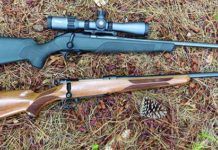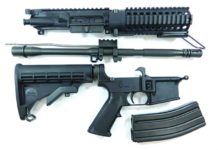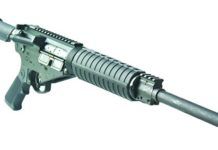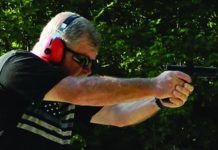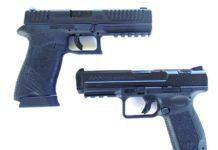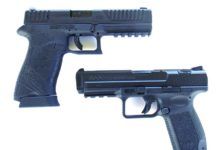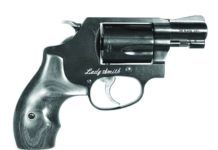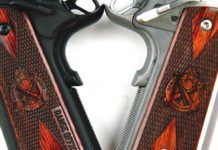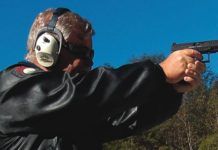Classy European Bolt Guns: Mauser M12 and Blaser R8 Pro
Germany has always been a leader in firearms development both for military and sporting use. The country also has a rich history of hunting. We wanted to take a look at two rifles with Teutonic hunting heritage, so we asked our dealers to wrangle up a Mauser M12 and Blaser R8. If there ever was an iconic bolt-action rifle on both sides of the Atlantic, it is the Mauser. Since 1871, Mauser has produced countless military and sporting bolt-action rifles. Mauser M98 rifles have been copied by many other rifle makers. Hallmark Mauser design features, like the action, three-position safety, and internal box magazine are built into rifles made by companies like Rigby, Winchester, CZ, Kimber, and others. The M12, however, is not a control-feed bolt action but is actually a push-feed bolt like a Remington, Sako, Weatherby, and others.
The Blaser (pronounced BLAH-zer) is a unique take on the bolt-action rifle because it uses a straight-pull bolt and offers interchange barrels in a range of calibers for gophers to elephants. Blazer had made a name for itself as an innovator of luxury hunting rifles, and though it could be debated that this German rifle is over engineered, we found some innovative features on a hunting rifle we didn't know we needed or wanted.
Either rifle would make an excellent deer rifle, we found, as well as top choices to take black bears, wild pigs, speed goats, and other hooved North American game. They both performed well in operation and in accuracy and after spending quality time with them, we can see why they command such a high price.
Both rifles were chambered in 30-06 Springfield, which is the benchmark caliber for American hunting cartridges. Our testers have a lot of experience with the cartridge, and we suspect that every bolt-action hunting rifle currently sold in the U.S. is available in 30-06. The round is versatile, easily found in stores, offers a range of bullet types and weights, and is at the upper level of tolerable recoil, especially when shooting the round out of lightweight hunting rifles. Both of these rifles hovered at seven pounds unscoped. For ammo in this test, we used Black Hills Gold loaded with a 180-grain Nosler AccuBond bullet and two hunting rounds from Hornady: Full Boar with a 165-grain GMX bullet and American Whitetail with a 150-grain InterLock bullet.
We mounted the rifles with the same optic, a SIG Tango6 2-12x40mm ($1600; CheaperThanDirt.com). This is a first focal plane-reticle scope, so the reticle increases and decreases in size as the magnification is increased or decreased. Testers liked this FFP scope because the milling reticle can be used at any magnification to estimate range. The Tango6 is equipped with an illuminated MOA Milling reticle. We could adjust reticle illumination as needed, and if we forgot to turn it off, the scope automatically turns off the illumination after six minutes of rest and powers back on as soon as it senses motion. We would have liked a parallax adjustment knob to really fine-tune the reticle, since we noticed the reticle moved ever so slightly as we moved our head and eye. Not a lot of movement, but enough to note. The scope also features Zerolock turrets, which means you can't lose zero if you rotate the turrets too much in either direction. Turret dials need to be pulled out to make adjustments then pushed back. Adjustments could be felt and seen easily, so getting our dope was simple after bore sighting. All adjustments were clearly marked, which we liked. The magnification ring used two fiber-optic dots that glowed to give the user a heads up on the magnification the scope was set at. Turrets and the magnification ring were toothy, with lots of texture, so rotating the dials was effortless. We could adjust the reticle easily while looking at it on target. For mid-range and typical hunting distances, we think the SIG scope would be a fine choice on these rifles. Where the bullet hits the paper is the real test of how well these rifles will do in the game field and deer stands. Here are the details on these luxury game getters.
380 ACP Loads Update: Choices Are Getting More Interesting
In the October 2010 issue we published a report on 380 ACP defense loads. The work was interesting and reader feedback intensive. During the tests, the loads proved accurate and reliable. The problem was the balance of expansion and penetration. We had either adequate expansion or good penetration but not each in the same loading. Some loads penetrated as little as 9 inches, with the average load at 12-13 inches. Expansion was modest in most cases. As a result, we felt that the full-metal-jacketed non-expanding bullet was a viable choice because there was a chance it would reach vital areas and create a stoppage. Surprisingly, even FMJ loads penetrated but 14 inches in water in that test. So, the search was on for a loading that might offer superior performance to the original test choices.
This time, we tested ten different loads using the same media — water and water jugs — and came away with a couple of loads that showed good promise for personal defense.
Since our initial test, many readers have continued to ask us about the effectiveness of the 380 ACP outside the ability to make highly accurate cranial shots. If the bullet cannot be counted on to reach the vitals, then it would hardly be of much use even if it did expand. However, FMJ loads do not necessarily solve every problem. A lightweight FMJ bullet is far more likely to stop short in penetration than a heavier bullet of moderate velocity. Often, a heavier-for-the-caliber-bullet will penetrate more even at lower velocity.
In our experience, modern shooters tend to look at the 380 as a lighter alternative to the 9mm, but a better comparison is between the 38 Special snubnose and the 380. So, as a point of reference, we included a middle-of-the road 125-grain JHP 38 Special +P load fired from a 2-inch-barrel revolver to represent an average for performance with the 125-grain JHP. It makes a striking example of how the 380 ACP fares against what we believe is at least an adequate 38 Special load. Also, for your convenience, we've listed the performance of the first round of 380 ACP loads we tested six years ago. Also, the top-ranked loads from the first test were the Fiocchi FMJ 95-grain No. 380FMJB and Speer Gold Dot 90-gr. No. 23606.
Takedown ARs from DRD, Ruger, Windham: Who Takes the Cake?
Espionage novels and movies are filled with rifles that are transported in a brief case, quickly assembled, then used to fire incredibly accurate shots. But is the ability to transport a disassembled AR in a small case or knapsack more intriguing than practical? Couldn't an AR already be considered a takedown rifle? Can't you just disassemble the lower receiver from the upper receiver and tote the two pieces in a duffle bag? These were a few questions team members had as we started looking into takedown AR-15s.
On one side of the debate, a takedown AR can be discreetly carried without the normal gun case that announces to all what is inside. A takedown AR is something one might consider adding to his bug-out gear should flood, fire, or worse coming knocking on the door. Takedown ARs also have the ability to swap calibers, allowing a user to perhaps opt for 300 AAC Blackout on a pig hunt, use the 5.56mm NATO for home defense, and 9mm for low-cost training. This caliber-swap feature gives these ARs the ability to use whatever ammo is available at the moment. We've all experienced the ammunition shortages of the recent past, and there is no reason to think it won't happen again. These ARs can feed whatever ammo is available. Another plus on the takedown AR side is easier cleaning.
On the other side of the debate, parts that are assembled and reassembled wear faster than parts that are fixed, and the more complicated a design, the more likely it is to break and the harder it is to get spare parts. Also, we wondered how zero might shift when removing then replacing the same-caliber barrel? And, how would a different caliber affect point of impact? Of course, price is always a consideration, and the cost of these takedown ARs is high — more than four times the cost of an entry-level 5.56mm AR priced at about $550. Can't a shooter just buy two rifles and set them up with optics at the same cost or less?
To answer these and other questions, we gathered three models from DRD Tactical, Ruger, and Windham Weaponry. These manufacturers have taken the modularity characteristics of the AR to a new level, each offering its own unique takedown design. Operationally, the DRD and Windham are direct-gas-impingement models; the Ruger uses a piston system.
All in, these takedown rifles get smaller by separating the barrel from the rail, which we estimate as a reduction in length of about 8.5 inches. With all three takedown ARs, the rifle is broken down into three main components. One thing to note: The rails or handguards on these rifles are not compatible with aftermarket parts. You must use the handguard the AR is shipped with because it is a key part of the takedown design. You can, however, customize these ARs with other aftermarket parts like stocks, pistol grips, triggers, sights, controls, muzzle devices, and so on.
American AK-Mag Variants II: Century, RRA, CMMG Go At It
Last month, we began testing AK-pattern rifles built in the U.S., which itself is important to a lot of Gun Tests readers, but also because we wanted to take an in-depth look at the category of what we hoped might be "improved" domestic variants of this famous rifle. Over the years, we've admired various AKs for their reliability while we've criticized their accuracy, fit and finish, and shooter-experience packages, such as crappy triggers and uncomfortable stocks. That said, we were very pleased with three rifles we tested in the June issue, rating one as a Grade A gun (Palmetto State Armory AK-47 MOE Edition 7.62x39mm, $749), a second as a Grade A- rifle (Century Arms RAS47 Magpul-Zhukov 7.62x39mm, $800), and the third a B+ (Palmetto State Armory AK-47 Gen2 Classic Red 7.62x39mm, $849).
This time we pit what are probably the two most significant military rifle actions of the 20th century against each other, the Kalashnikov and the Stoner. But there is a twist: All four rifles are American made, are chambered in 7.62x39, and use Kalashnikov-pattern magazines. The two Kalashnikov actions are made by Century Arms and look very much like standard AK-pattern rifles. The two Stoner actions, made by Rock River Arms and CMMG, for the most part look like the AR-15 platform familiar to many shooters but have some unique features. The Kalashnikovs have a well-deserved reputation for reliability, and the Stoners have a well-deserved reputation for accuracy. So, how would they do head to head?
To find out, we fired all four rifles in both cold and hot conditions, and because we expect these rifles to be used both as plinkers and for hunting or rural self defense, we used four different types of ammunition for this test: 122-grain FMJs, 123-grain plastic-tipped hollowpoints, 124-grain soft points, and 154-grain soft points. Due to the fairly big groups shot with open sights at 100 yards last time, this round we fired five-shot groups at 50 yards and measured them from center to center. Here's what we learned.
Glock Night Sights: We Test Glow-in-the-Dark Aiming Aids
As a carry handgun, the Glock is rugged, reliable, and combat worthy. About the only modifications that actually improve the Glock are the addition of a better trigger and a set of aftermarket sights. We dealt extensively with the issue of trigger replacements in the April 2014. There, we installed a Zev Technologies' GlockWorx Ultimate kit from Brownells.com ($250, #100-006-566WB, Mfr. Part: ZTFULULT4G9BLK) into our Glock 17. We gave the Ultimate Kit an A grade, saying it "was the upgrade that produced the biggest difference in performance all by itself, increasing the accuracy of the Glock 17 from an average grouping of 2.3 inches down to 1.6 inches."
Also in the April 2014 issue, we looked at two sight-upgrade kits, both from Brownells. One was the Brownells Glock 17 Sight Upgrade Kit ($200, #080-000-919WB), which included a Meprolight (Kimber) ML-10224 Tru-Dot Night Sight System for Glock 17, 19, 22, 23, 31, 32, 33, 34, 35, 37, 38, 39; an MGW Glock Sight Adjustment Tool, and an Ed Brown Front Sight Tool for Glock. Since we had the installation tools handy, we also ordered a set of TruGlo tritium fiber-optic Brite-Sites ($90, #902-000-107WB, Mfr. Part: TG131GT1Y), yellow rear and green front. We chose to put the TruGlo sights on the Glock 17 and the Tru-Dots on a G34 so that we could shoot them side by side.
With the Ed Brown Front Sight Tool for Glock ($20 sold separately, #087-017-001WB, Mfr. Part: 952) and the MGW Glock Sight Mover ($100 sold separately, #584-045-017WB, Mfr. Part: MGW309) for the rear sight, we started the switch with a disassembly of the slide to get access to the front sight. With the Ed Brown front sight tool and a small crescent wrench, we loosened the screw beneath the sight and removed it, then replaced the white dot with the new TruGlo front sight and tightened with the crescent wrench. Once the front sight was swapped, we hooked the slide into the MGW. The device came with some thin plates to raise the slide up the right height. We did not need them. The old sight drifted out with relative ease, going left to right pointed away from us. The new rear TruGlo sight did require some minor fitting with a file and a little more strength to slide in, but with the MGW tool, leverage was not a problem. We used the same process to put the Meprolite sights onto a factory Glock 34.
Despite the new TruGlo sights being fixed like the originals, we found them to be much clearer and easier to acquire and reacquire targets. We took to the range with the TruGlo sights installed, using all other original parts, and we cut our average group size down by almost half an inch, from 2.3 inches with the standard Glock to 1.9 inches with the TruGlo sights. We turned down the lights over the shooters, leaving the targets illuminated to check out how much the tritium would glow in the fiber-optic sights. The green front sight was quite bright, while the rear yellow sights were significantly dimmer, although still visible.
The Meprolight Tru-Dots provided an even more impressive change on the G34. We shaved just over a full inch off our average group size at 10 yards once we installed them.
Upgrading fixed sights can seem like a challenge to someone who hasn't done work on pistols previously, but with these tools and the simplicity of Glock's designs, this upgrade is a great place to start if you want to attempt a DIY project. You can drift the sights out with a punch, which will save $100 for the MGW tool, but you risk rupturing the tritium capsules. The MGW mover requires oil on the crankshaft, but it made drifting the dovetail sights in and out so easy we quickly misplaced our punch set. Overall, we found the TruGlo sights to be a nice upgrade and would recommend putting them in place of the standard non-tritium sights on any factory Glock. We gave them a Grade: A ranking, along with the Meprolight Tru-Dot tritium.
Naturally, readers asked about other sights, so we began looking at more replacements we could test head to head, rather than as a general Glock upgrade. So, again working with Brownells, we assembled a sextet of night sights suitable for installation on various Glocks. Also, we believe you can broaden our recommendations to include other firearms of similar size — the visual presentation won't be appreciably different on different platforms — though the installation process may differ gun to gun.
Century Versus Diamondback: Affordable 9mms Butt Heads
The high-capacity 9mm handgun continues to be a popular personal-defense choice, for good reason. Many of the finest handguns in the world are chambered for the 9mm Luger cartridge and nothing else. In a handgun of 30 ounces or so, loaded recoil is light to manageable. Practical accuracy may be outstanding. A magazine capacity of 15 rounds or more is reassuring and gives a good reserve of ammunition. With these considerations in mind, we tested two modern economy-grade 9mm handguns whose performance was acceptable, especially considering the price, though our shooters found we liked one pistol better.
These two handguns are large for concealed carry, but they are light enough and may be concealed with enough effort and an intelligent holster choice. Certainly, they can be employed in the home, where overall size is less of an issue. Those firing and using compact handguns may not realize how easy bigger handguns are to use well compared to a pocket model.
One such larger handgun that is affordable to boot is the Century Arms TP9SA, which is listed in the company's catalog as SKU HG3277-N. A similar desert tan model is HG3277D-N. We found one selling for $346 atBudsgunshop.comand another one on sale at Cabela's for just under $300. This handgun is manufactured by Samsun Yurt Savunma, a Turkish gun maker, and imported by Century Arms of Delray Beach, Florida. The TP9SA and many of its accessories are marked "Canik," for the Canik 55 division of the manufacturer. So, to be plain about it, the Century Arms TP9SA is a Canik 55 9mm pistol, similar in outline to the Smith & Wesson SW99 and Walther P99. There are enough differences between the Canik and the Walther pistol to say the former is not a clone of the latter, but the Century import is obviously similar to a comparable Walther, being a service-size 9mm with a polymer frame and mid-length slide and a 4.25-inch barrel. Our second test gun was the Diamondback Firearms DB FS Nine DB9FS 9mm Luger, which lists for $483, but which we found at Budsgunshop.com selling for $265. Founded in 2009, Diamondback Firearms is based in Cocoa, Florida.
The Diamondback DB9FS is a striker-fired polymer-frame pistol that in general outline resembles the Glock 17. Our shooters noted that the pistol feels different than a Glock, and the overall configuration is markedly different than the Glock. Here's more about these two affordable 9mm pistols.
Century Versus Diamondback: Affordable 9mms Butt Heads
The high-capacity 9mm handgun continues to be a popular personal-defense choice, for good reason. Many of the finest handguns in the world are chambered for the 9mm Luger cartridge and nothing else. In a handgun of 30 ounces or so, loaded recoil is light to manageable. Practical accuracy may be outstanding. A magazine capacity of 15 rounds or more is reassuring and gives a good reserve of ammunition. With these considerations in mind, we tested two modern economy-grade 9mm handguns whose performance was acceptable, especially considering the price, though our shooters found we liked one pistol better.
These two handguns are large for concealed carry, but they are light enough and may be concealed with enough effort and an intelligent holster choice. Certainly, they can be employed in the home, where overall size is less of an issue. Those firing and using compact handguns may not realize how easy bigger handguns are to use well compared to a pocket model.
One such larger handgun that is affordable to boot is the Century Arms TP9SA, which is listed in the company's catalog as SKU HG3277-N. A similar desert tan model is HG3277D-N. We found one selling for $346 atBudsgunshop.comand another one on sale at Cabela's for just under $300. This handgun is manufactured by Samsun Yurt Savunma, a Turkish gun maker, and imported by Century Arms of Delray Beach, Florida. The TP9SA and many of its accessories are marked "Canik," for the Canik 55 division of the manufacturer. So, to be plain about it, the Century Arms TP9SA is a Canik 55 9mm pistol, similar in outline to the Smith & Wesson SW99 and Walther P99. There are enough differences between the Canik and the Walther pistol to say the former is not a clone of the latter, but the Century import is obviously similar to a comparable Walther, being a service-size 9mm with a polymer frame and mid-length slide and a 4.25-inch barrel. Our second test gun was the Diamondback Firearms DB FS Nine DB9FS 9mm Luger, which lists for $483, but which we found at Budsgunshop.com selling for $265. Founded in 2009, Diamondback Firearms is based in Cocoa, Florida.
The Diamondback DB9FS is a striker-fired polymer-frame pistol that in general outline resembles the Glock 17. Our shooters noted that the pistol feels different than a Glock, and the overall configuration is markedly different than the Glock. Here's more about these two affordable 9mm pistols.
Revolvers for the Elderly, New Virginia Laws, Henry Rifles
In last month's Firing Line, reader Winslow asks for advice on a 357 magnum lightweight snubnose revolver for a 75-year-old female cousin. I would appreciate a little help. I'm wondering why these two diametrically opposed 308s were chosen to oppose one another. While I am not in one of the affected states, I am from Vermont, and we do not require a permit for CC, and no state recognizes our not needing a permit! Whatever happened to the personal pride everyone took in their ownership of not only a working tool, but also a masterpiece of design and artwork?
I have read recent Gun Tests articles on various AR rifles, so I recently built an AR with a folding stock. I was attracted to this option because I drive a sports car, and even with a collapsible stock and 16-inch barrel, an AR will not fit in the trunk. The folding stock adapter I chose was one made by Law Tactical (LawTactical.com). It was easy to install, works fine to fold the stock, and adds just a little bit of fiddling when I have to separate the upper and lower. But it is very expensive and adds no additional operating functionality to the firearm, since it should never be fired with the stock folded. Anyway, I have not seen many options for folding stocks on an AR platform, and thought that a review of adapters for them might be in order.
Springfield 9mm 1911s: Loaded Versus Range Officer Showdown
There are many good reasons for purchasing a 1911 in the non-traditional 9mm Luger cartridge. Compared to 45 ACP, 38 Super, and 10mm, 9mm Luger ammunition is less expensive and easy to come by. Also, the 9mm is only improved when fired from the 1911, with that platform's solid ergonomics, reliability, and distinctive appearance. In a 1911, the 9mm is easy to shoot well, despite a history in which 9mm target guns were seldom as accurate as a properly set up 45. As it turns out, the 9mm 1911 with modern ammunition is plenty accurate. Some shooters might also worry that 9mm 1911s might be less reliable, but we can only say that in our small sample of hundreds of rounds, two tested 1911 9mm handguns were reliable.
Where do such guns fit in? For one, the 9mm 1911 is a great target and competition handgun. Just as a cowboy-action shooter may choose a 38 Special SAA for economy and low recoil, an IDPA shooter may find the 9mm affords economical practice without creating waves in the arm from recoil. The self-defense shooter need not worry either, because with +P loads, the 9mm is no slouch in the wound-ballistics department.
We have had calls to choose between two closely matched stablemates from Springfield Armory, and both the Loaded Target PI9134LP and the Range Officer PI9129LP are traditional full-size 9mm pistols. This simply means that they are based upon the 45 ACP's frame. They are very similar to 38 Super pistols, save for a breech face of 0.384 versus 0.405 inch for the 38 Super. By changing a barrel and opening the breech face, the 9mm pistol may be converted to 38 Super. As you may imagine, converting a 38 Super to 9mm is a bit easier since the larger breechface usually works okay with both cartridges. (Exceptions: The Para USA LDA 9 and the Springfield EMP 9mm are 9mm pistols that are a bit smaller in dimension than the full-size Springfield pistols. They cannot be converted to the 38 Super.)
The full-size 9mm handguns are designed to fill a niche for those favoring the 9mm, or those simply wishing to own a lighter-kicking 1911 than one chambered in 45 ACP or 40 S&W.
The 9mm Range Officer has the same forged national match frame and slide as the Trophy Match and TRP 1911s. It gets the same precision fit as those more expensive pistols, Springfield says. Likewise, it uses the same match-grade stainless-steel barrel and bushing and is topped with a fully-adjustable rear target sight. This is a great help to us in adjusting point of aim to point of impact when we're shooting different bullet weights. It has a single-sided thumb safety.
The Loaded 9mm Stainless Steel has a polished finish on the flat surfaces and bead-blasted matte finish on the rounded areas. The 5-inch barrel is a match-grade stainless steel unit. The slide features slanted serrations on the front and rear, where the RO has only rear cuts. The mainspring housing is flat and includes the company's integral locking system, or I.L.S., which replaces the mainspring housing of the handgun. When engaged, the I.L.S. prevents the hammer from moving by locking the mainspring cap, making the gun inoperable. Elsewhere, the pistol has a lightweight Delta hammer and a beavertail grip safety with raised memory pad for positive engagement. The extended thumb safety is ambidextrous, and its long aluminum match-grade trigger separate it from the RO. The pistol is fitted with a two-piece full-length guide rod. The grips are held in place with Torx grip screws that look nice and distinguish it from the RO.
During the evaluation, both handguns were field stripped. Interestingly, the Range Officer slide easily slipped on the Loaded Model Frame. The Loaded Model slide, however, was too tight on the Range Officer frame to function. Since modern 1911 handguns are not disassembled and thrown into a barrel on Guadalcanal for cleaning, then assembled regardless of original set up, this is acceptable and also interesting. The Range Officer seemed to have the tighter barrel bushing lockup. The barrel was a tight fit overall. We were surprised that the barrel bushing was only finger tight with the Range Officer.
But what matters is the shooting, and what our team found is that these 1911s chambered in 9mm Luger make for a very pleasurable shooting experience. An accurate 1911 in 9mm is even more enjoyable. Here's more of what we learned about them when firing them side by side:
The Pig Box and TSA
I admit I was miffed when the Transportation Security Administration (TSA) opened a computer case I checked as baggage to Las Vegas for the SHOT Show back in January. The case and contents were a load — a 38-pound Pelican 1730 transport case with a 27-inch iMac in it. I prefer to use a desktop machine to update the Gun Tests Facebook page, YouTube page, website, and new-product files when I'm at SHOT for a week. I've done the jobs with a laptop before, and I admit, it's much easier to carry-on a smaller machine. But once it's set up, the full-size iMac is heaven while we're processing words, photos, and movies for our various media in a hurry. In previous years, I had shipped my back-up iMac 27 in its original box a few days prior, so I hadn't had to wrestle what I lovingly refer to as the Pig Box through airport check in. I call it that because the Pelican is big enough (37.5 x 27.1 x 14.4 inches) to hold a whole pig. Oh yes, extra weight and size charges apply.
Polymer-Frame 9mm Shoot Out: P320 Versus PPQ M2 Vs. VP9
During the past few months, SIG Sauer, Walther, and Heckler & Koch have introduced pistols that feature striker-fired actions. These handguns are designed to compete for the hearts and minds of institutional buyers and concealed-carry-permit holsters as well. The improvement in rapid-fire combat shooting is provable, and absolute accuracy is improved over the original SIG P250, Walther P99 and HK P30. The question is, which handgun is the most improved and the best buy for the money — that is, the most reliable and accurate?
In this test of three 9mm striker-fired models, we were firing handguns intended for personal defense in the home, concealed carry, and practical competition. We are certain each maker is hoping to compete with Glock for institutional sales as well. At first glance, the handguns appeared similar. Each featured a polymer frame, a light rail, and similar sights. Each was relatively simple to operate. None had a manual safety as part of the design. Some features, such as the sights and the magazines, were similar. A casual shooter might sign off on all three handguns, but that isn't what we do.
Our shooters noticed the trigger actions were markedly different, and grip texturing and handling were considerably different. As the firing sessions progressed and the brass stacked up, the shoot out turned into a strong challenge between the Walther and the HK pistol. These worthy competitors traded places several times in the firing evaluations. The SIG P320 brought up the rear, in our estimation. Here's why:
JOX Loader Pouch Test
Many Americans choose a revolver as their concealed-carry handguns. Most carry a snubnose revolver; a few carry a 4-inch barrel 357 Magnum like those tested elsewhere in this issue. Their faith in the revolver is understandable. Our raters observe that criminals often run in packs. The natural polarity between good guys and bad guys may erupt into a gun battle. While high-round counts are not the norm, the possibilities are endless. At any rate, after you win the fight, you will wish to reload the handgun, which means carrying spare gun loads - a somewhat more difficult task than with magazines for a self loader. We believe the reason the revolver reload isnt carried as often is because of the bulk of speedloaders, and carrying loose ammunition in the pocket is a bad choice. Revolver speed strips help, but are far from ideal. In our view, a revolver speedloader is best, but they are about as wide as the revolver cylinder, which makes for a bump on the belt with conventional old-style speedloader pouches.




























